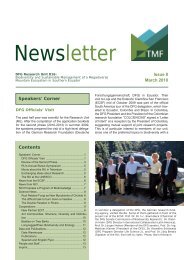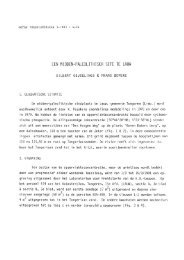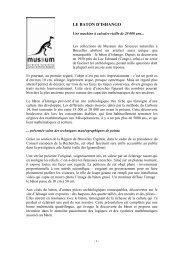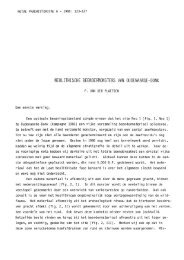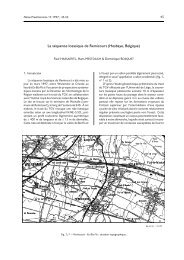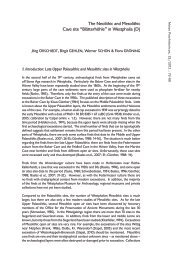Terebratula Daleidensis - Royal Belgian Institute of Natural Sciences
Terebratula Daleidensis - Royal Belgian Institute of Natural Sciences
Terebratula Daleidensis - Royal Belgian Institute of Natural Sciences
You also want an ePaper? Increase the reach of your titles
YUMPU automatically turns print PDFs into web optimized ePapers that Google loves.
62 Paul SARTENAER<br />
Fig. 1 –<br />
Oligoptycherhynchus hexatomus (SchnuR, 1851). Camera lucida drawings <strong>of</strong> serial transverse sections; figures are<br />
distances in mm forward <strong>of</strong> the ventral umbo. IRScNBa12712. Üxheim (Hillesheim Syncline, lower Nohn Beds, upper<br />
Lower Eifelian). Measurements: length = 16.3 mm; width = 21.7 mm; thickness = 15.8 mm.<br />
Trigonirhynchia CoopeR, 1942 differs from<br />
Oligoptycherhynchus in most characters. The genus is<br />
only mentioned here, because Schmidt (1965, p. 6),<br />
although underlining obvious differences, considered<br />
that Camarotoechia daleidensis and C. hexatoma had<br />
some features (outline, pr<strong>of</strong>ile, costae) in common with<br />
its type species Trigonirhynchia fallaciosa Bay l e,<br />
1878 (Pragian, Armorican Massif).<br />
Stratigraphic position and geographic location<br />
In a remote past, Oligoptycherhynchus daleidensis<br />
has been mentioned in the type area (Daleiden<br />
“Muldengruppe” and adjoining region <strong>of</strong> the Grand<br />
Duchy <strong>of</strong> Luxembourg = type area stricto sensu, and<br />
Prümer Syncline = type area lato sensu) from the<br />
“Spiriferensandstein”, the Daleiden-, Eifel-, Hierges-,<br />
Rhine (Rhenish)-, and Waxweiler-“Grauwacke”, and<br />
from the Daleiden-Waxweiler beds. A more precise<br />
lithostratigraphic unit, covering the upper part <strong>of</strong> the<br />
“Grauwacke”, the “Oberk(c)oblenzschichten” came<br />
progressively in use.<br />
O. daleidensis is now restricted to the Upper<br />
Emsian Wiltz Beds (“Wiltz-Schichten”), <strong>of</strong> which it is<br />
a characteristic species (see e.g. StRuve, 1964, p. 227;<br />
WeRneR, 1980, p. 14; KowalSki, 1983, p. 101).<br />
The presence <strong>of</strong> the species in Germany outside<br />
the type area has still to be substantiated. The undue<br />
importance given to a given number <strong>of</strong> median costae<br />
4<br />
), considered the most important character, if not the<br />
(<br />
3<br />
only one, <strong>of</strong> O. daleidensis, has led to the assignment<br />
to that species <strong>of</strong> a long string <strong>of</strong> Siegenian and<br />
Emsian forms. No specimen has been spotted in the<br />
various collections examined by the author. Evidence



